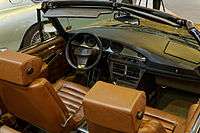Citroën SM
The Citroën SM is a high-performance coupé produced by the French manufacturer Citroën from 1970 to 1975. The SM placed third in the 1971 European Car of the Year contest, trailing its stablemate Citroën GS, and won the 1972 Motor Trend Car of the Year award in the U.S.
| Citroën SM | |
|---|---|
_-_15340846543.jpg) | |
| Overview | |
| Manufacturer | Citroën |
| Production | 1970–1975 |
| Designer | Robert Opron |
| Body and chassis | |
| Class | Grand tourer |
| Body style | 3-door hatchback coupé |
| Layout | MF layout |
| Related | Citroën DS Maserati Merak Maserati Quattroporte II |
| Powertrain | |
| Engine | 2.7 L 90° V6 3.0 L 90° V6 |
| Transmission | 5-speed manual 3-speed automatic |
| Dimensions | |
| Wheelbase | 2,900 mm (114.2 in) |
| Length | 4,893 mm (192.6 in)[1] |
| Width | 1,836 mm (72.3 in) |
| Height | 1,324 mm (52.1 in) |
| Curb weight | 1,460 kg (3,219 lb) (carburetted version) 1,520 kg (3,351 lb) (fuel-injection version) |
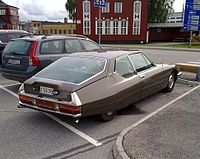
History
In 1961, Citroën began work on 'Project S' – a sports variant of the revolutionary Citroën DS. As was customary for the firm, many running concept vehicles were developed, increasingly complex and upmarket from the DS.[2] At some stage in the 9-year project, it evolved from developing a faster variant of the 1955 DS to developing an entirely new, thoroughly engineered car – in terms of engineering effort, a replacement for the high volume DS model. Citroën purchased Maserati in 1968 with the intention of harnessing Maserati's high-performance engine technology to produce a true Gran Turismo car, combining the sophisticated Citroën suspension with a Maserati V6.[3]
The result was the Citroën SM, first shown at the Geneva Motor Show in March 1970. It went on sale in France in September of that year. Factory produced cars were all left-hand-drive, although RHD conversions were done in the UK and Australia.
This car was unusual for France – the thriving French luxury car industry was decimated by post-World War II puissance fiscale regulation, which has hamstrung French manufacturers for decades, so France had not had a production vehicle in this segment after World War II.[4] The SM had an unusually small engine of 2.7 liters due to these regulations; it was the first response to the luxury/performance sector since the export oriented Chrysler V8 engine Facel Vega in the late 1950s.[5] Citroën's flagship vehicle competed with high-performance GTs of the time from other nations and manufacturers, such as Jaguar, Lotus, Ferrari, Aston Martin, Alfa Romeo, Mercedes-Benz, and Porsche.
The origin of the model name 'SM' is not completely clear. The 'S' may derive from the Project 'S' designation, the aim of which was to produce what is essentially a sports variant of the Citroën DS, and the 'M' perhaps refers to Maserati, hence SM is often assumed to stand for "Systeme Maserati" or "Sports Maserati". Another common alternative is Série Maserati,[6][7] but others have suggested it is short for 'Sa Majesté' (Her Majesty in French), which aligns with the common DS model's nickname 'La déesse' (The Goddess).
The SM did not find a sufficient customer base in the small European GT market, but much of the SM's technology was carried forward to the successful Citroën CX, launched in 1974 the DIRAVI steering being the most obvious example. The same basic engine in enlarged 3.0 L form (some in Italy had 2.0 L) was used in Maserati's own Merak (1,800 units) and later with some modification in the Biturbo (40,000 units).[8] The Merak, Khamsin, and Bora, used Citroën's high-pressure hydraulics for some functions, and the Citroën gearbox in the Merak, during the Citroën-Maserati alliance.
Performance
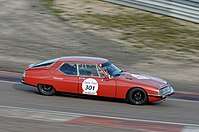
Contemporary automotive journalists were effusive about the SM's dynamic qualities, which were unlike anything they had experienced before.[9] The SM provided a combination of comfort, sharp handling, and braking not available in any other car at the time.[10] The magazine Popular Science noted that the SM had the shortest stopping distance of any car they had tested.[11]
Automotive journalists marveled at the resulting ability to travel for hours at 200 km/h (124 mph) in comfort.[12] In 1972 Motorsport (U.K.) noted ..."that rare quality of being a nice car to be in at any speed, from stationary to maximum."[13] The touring range based on the SM's fuel economy and the large 90 l (20 imp gal; 24 US gal) fuel tank made long, fast, relaxing journeys possible.[14]
Because the SM had a small 130 kW (174 hp) engine, the acceleration was adequate rather than exemplary – some competitors were quicker. Some owners have fitted the similar sized 160 kW (215 hp) Maserati Merak SS engine, which does improve the driving experience considerably.[15]
Fuel consumption compares favorably to most competitors.
| Make & model | Horsepower 'SAE net' | Top speed | Acceleration 0 to 60 mph (0–97 km/h) | Fuel economy |
|---|---|---|---|---|
| Citroën SM | 130 kW (174 hp) | 220 km/h (137 mph) | 8.5 sec | 12.5 l/100 km (22.6 mpg‑imp; 18.8 mpg‑US)[16] |
| Mercedes-Benz 450 SLC | 141 kW (189 hp) | 202 km/h (126 mph) | 9.5 sec | 15 l/100 km (19 mpg‑imp; 16 mpg‑US)[17] |
| Jensen Interceptor | 187 kW (251 hp) | 217 km/h (135 mph) | 7.5 sec | 24 l/100 km (12 mpg‑imp; 9.8 mpg‑US)[18] |
| BMW 3.0CS | 141 kW (189 hp) | 200 km/h (124 mph) | 7.9 sec | 15.5 l/100 km (18.2 mpg‑imp; 15.2 mpg‑US)[19] |
| Jaguar XKE Series III V12 | 187 kW (251 hp) | 217 km/h (135 mph) | 6.8 sec | 18 l/100 km (16 mpg‑imp; 13 mpg‑US)[20] |
| Continental Mark IV | 158 kW (212 hp) | 190 km/h (118 mph) | 10.8 sec | 25.3 l/100 km (11.2 mpg‑imp; 9.3 mpg‑US)[21] |
| Cadillac Eldorado | 175 kW (235 hp) | 189 km/h (117 mph) | 9.7 sec | 26.2 l/100 km (10.8 mpg‑imp; 9.0 mpg‑US)[22] |
Technical innovations
The SM combines many unusual and innovative features, some of which are only just becoming commonplace on cars of today.[23] It borrows heavily from the innovations introduced on the DS, by including hydro-pneumatic (oleo pneumatic) self-leveling suspension, and self-leveling lights that swiveled with the steering (except in the USA where these were illegal at the time).
The SM was Citroën's way of demonstrating just how much power and performance could be accommodated in a front-wheel drive design. This was novel, and many technical issues needed to be overcome, especially related to torque steer, where excessive steering feedback affects control of the vehicle.
A solution was found – no road feedback at all – the driver points and goes, regardless of what the driven wheels are experiencing.[10][24] Hitting a pothole at high speed would not turn the steering wheel in the driver's hands.
.jpg)
.jpg)
.jpg)
This new type of variable assist power steering was later fitted to the Citroen CX in large numbers and its basic principle has since spread throughout the vehicle population.[23] DIRAVI as it was called, allowed great assistance to the motorist while parking, but little assistance at motorway speeds. The system adjusts the hydraulic pressure on the steering centering cam according to vehicle speed so that the amount of steering feel remained almost constant at any speed, counteracting the tendency of manual and ordinary power assisted steering to feel light at high speed. Thus the car turns easily at low speed, emphasized by high gearing given two turns lock-lock, and relatively more effort is required at higher speed.
If the driver released the steering wheel, then the steering would center back to the straight ahead position. It was geared for minimal steering input – with 2 turns from lock to lock, often described as like a go kart.
Many contemporary reviewers remarked that this system would take at least 80 km (50 mi) of driving to become familiar, but once the driver is accustomed to the system, then traditional steering feels old-fashioned.[25]
This steering was controversial at the time – the exaggerated, strong-arm steering inputs required in contemporary cars could cause abrupt manoeuvres in the SM.[9] When the SM was cast as a TV series regular on 1972's The Protectors, the lead actress refused to drive it, because of the familiarization required from the steering.[26]
The DIRAVI steering is self-centering and fully powered (as opposed to hydraulically assisted). This feature allows the front wheels to run near-zero caster, and means that there is no camber change as lock is applied, and also ensures that the maximum amount of tyre area is in contact with the road at all times.
The wiper mechanism, when on the "low speed" setting, is 'sensitive' to rain, by measuring the current needed to drive the wiper motor, while the steering column is adjustable in both height and reach.[23]
The braking system, adapted from the DS, employs disc brakes at all four corners (the DS has drums at the rear), with the front brakes being inboard, and cooled via large ducts on the front underside of the car. The hydraulic braking pressure front to rear balance is self-adjusting according to the weight in the rear of the car, so on hard braking the entire car lowers evenly.[27]
Standard wheels are steel with stainless trims, but for the rigors of off-road racing, Michelin developed a unique solution – a lightweight carbon-reinforced resin wheel, which became a factory fitted option. These plastic wheels weigh less than half the standard weight and were decades in advance of similar applications.[28] The construction method is similar to the more brittle fiberglass material (some hobbyists even refer to them this way[29]), but the wheels contain carbon fibers, not glass fibers.[30]
Styling
Designed in-house by Citroën's chief designer Robert Opron, the SM bears a family resemblance to the Citroën CX and Citroën GS, and to some extent the Maserati Mistral. Like the CX, the SM retains the rear fender skirts, and seen from above, the SM resembles a teardrop, with a wide front track tapering to a narrower rear track.
The SM was unusually aerodynamic for its era, with Kamm tail and low drag coefficient of 0.26.[31] The ventilation intake is located in a "neutral" area on the hood, which makes the ventilator fan regulate the interior ventilation at all road speeds.
With its distinctly modernist influence, the interior styling of the SM is as dramatic as the exterior. The small oval steering wheel is matched by oval gauges. The manual shift lever 'boot' is a highly stylized chrome gate. The seats are highly adjustable buckets with centre padding composed of many individual 'rolls'. High-quality materials are used throughout. The bonnet is aircraft grade aluminum, while the external bright work is stainless steel, rather than 'cheaper' chrome (except for "plastichrome" "SM" trim at the rear base of the rain gutter).
In 1970, it was a car of the future and the fastest front-wheel-drive car, with a factory-quoted top speed of 220 km/h (137 mph), and independent tests achieving as much as 235 km/h (146 mph). It was an example of the car as a symbol of optimism and progressive technology, similar to the SM's contemporary, the Concorde aircraft.[32]
The SM's design placed eleventh on Automobile Magazine's 2005 "100 Coolest Cars" listing.
US exports
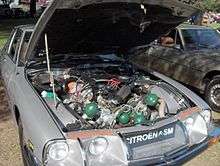
The main export market for the SM was the U.S. In the U.S., the market for personal luxury cars was much larger than in Europe, with competitors like the Cadillac Eldorado, Lincoln Mark IV and Ford Thunderbird alongside a large selection of Italian, British, and German imports.[33] Nevertheless, the unique design of the SM made quite a splash and won the Motor Trend magazine Car of the Year award in 1972: unheard of for a non-US vehicle at the time.[34]
The SM's six headlight set up was illegal in the U.S. at the time and consequently, U.S. specification cars were fitted with four fixed round exposed lamps.[33] Also, the separate glass windshields of the headlights were illegal in the US after 1967, which is why the DS did not get them on USA cars when it was restyled for 1968, and the VW Beetle and late split-window van and Jaguar E-Type lost their headlight glass windshields at the same time.[35]
Despite initial success, U.S. sales ceased suddenly – Citroën expected, but did not receive, an exemption for the 1974 model year 5 mph (8.0 km/h) bumper regulation imposed by the NHTSA.[33] The integral variable height suspension of the SM made compliance impossible.[33] [36] The final batch of 134 now illegal 1974 U.S. model SMs was shipped to Japan to be sold there.[37]
Engines
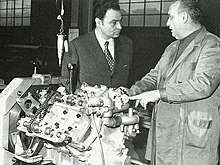
The SM was sold with a small, lightweight engine in various forms, designed from scratch by Giulio Alfieri but capable of being assembled on existing V8 tooling. Because of this, the engine sported an unusual 90° angle between cylinder banks – a trait shared with the later PRV V6. It was a very compact and innovative design that allowed the use of just one pattern for the cylinder heads and an intermediate shaft extended out to drive the auxiliaries.
The engine was aluminum, weighing just 140 kg (309 lb), and was always mounted behind the front axle.[38]
| Model | Serial number | Engine | Displacement cm3 |
Fuel supply | Horsepower PS SAE net |
Transmission/ N° gears |
Weight | Top Speed | Years of production |
Number produced |
| SM 2.7 | type SB | C114-1 | 2,670 | 3 Weber carburetors 42DCNF | 170 PS (125 kW; 168 hp) | M/5 | 1,450 kg (3,197 lb) | 220 km/h (137 mph) | 1970–72 | 7.133 |
| SM 2.7 Automatique | type SB | C114-1 | 3 Weber carburetors 42DCNF | 170 PS (125 kW; 168 hp) | A/3 | 1,480 kg (3,263 lb) | 205 km/h (127 mph) | 1972 | 675 | |
| SM 2.7 Injection | type SC | C114-3 | Electronic Injection Bosch D-Jetronic | 178 PS (131 kW; 176 hp) | M/5 | 1,490 kg (3,285 lb) | 228 km/h (142 mph) | 1972–75 | 3.500 | |
| SM 3.0 | type SD | C114-11 | 2,965 | 3 Weber carburetors 42DCNF | 180 PS (132 kW; 178 hp) | M/5 | 1,450 kg (3,197 lb) | 225 km/h (140 mph) | 1973 | 600 |
| SM 3.0 Automatique | type SD | C114-11 | 3 Weber carburetors 42DCNF | 180 PS (132 kW; 178 hp) | A/3 | 1,480 kg (3,263 lb) | 205 km/h (127 mph) | 1973–75 | 1.012 |
The size of the 2.7 L engine was limited by French puissance fiscale taxation, which made large displacement vehicles too expensive to sell in any quantity in France.[5]
One SM had a Maserati V8 motor – this was a heavily used test bed developed by Maserati for the 1974 Maserati Quattroporte II.[39] Despite developing 190 kW (260 hp), the car required relatively modest adjustments, and the performance made the SM into a true sporting car.[40]
One SM had a V6 twin Turbo – developed by specialist Jerry Hathaway (SM World) for land speed record testing at Bonneville Salt Flats – achieving 325 km/h (202 mph).[41]
Smooth shifting 5-speed manual transmissions were fitted to most SMs.[10] A 3-speed Borg Warner fully automatic transmission was an option in North America in 1972–73, and in Europe 1974–75.
The engine was also used in the Maserati Merak from 1972 to 1982. Later versions of the Merak SS had much larger valves and developed 160 kW (220 hp). The Ligier JS2 sports car also used this V6 engine. The final SMs were produced in the Ligier factory in Vichy.
Under new ownership, Maserati developed the 1981 Biturbo model, by applying turbocharging to this engine, and sold 40,000 units.
Motorsport
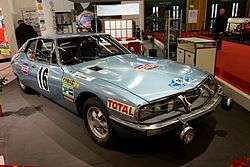
The SM won its first competitive outing, the gruelling 1971 Rallye du Maroc. Citroën continued rallying the SM, eventually developing a "breadvan" short-wheelbase racing variant.
SM World, a marque specialist in Los Angeles, California, produced a turbocharged SM, which in 1987 set the land speed record for production vehicles in its class at the Bonneville Salt Flats, Utah – traveling 325 km/h (202 mph).[41]
Demise
After the 1974 bankruptcy of Citroën, Peugeot took ownership of the company and in May 1975, divested Maserati. Peugeot decided to stop building the SM, as sales were just 115 units that year.
Observers often attribute the demise of the SM to the 1973 oil crisis and economic recession.[42][33]
While the oil shock certainly affected sales, many far more profligate cars were introduced at the same time the SM ceased production, including the hydropneumatically suspended Mercedes-Benz 450SEL 6.9. Peugeot even introduced a V6 powered car of similar displacement and fuel consumption in 1975, the 604. In the U.S. (the main export market for the SM), the SM was actually an economical vehicle relative to its competitors.[43] However, the U.S. National Highway Traffic Safety Administration (NHTSA) imposed new automotive design regulations in 1974, effectively banning the Citroën from the U.S. market.[33]
As illustrated under production numbers, SM sales declined starting in 1972. This appears to be attributable to maintenance issues.[33] Like an exotic Italian car, the Weber carburetors require frequent adjustment. Many engines experienced failure at 60,000 km – it was unclear to most owners that the interference engine design has timing chains that require manual adjustment, an issue not corrected until long after production ceased.[44] The 90° engine timing was unfamiliar to mechanics in the 1970s. Only Buick (1962–66; 1975–) and Jeep (1966–71) used a V6 with 90° between banks of cylinders. Another issue that has been resolved with retrofit was unreliable ignition breaker cassettes.
Most vehicles require only generalist maintenance, where any competent mechanic can properly maintain the vehicle. Certain vehicles – like Citroëns and Ferraris – require specialist care due to their unique design.[12] While a sturdy car if maintained rigorously, the SM did require two sets of specialist care – Citroën specialists, which are widespread in Europe, and a rarer Maserati specialist, to keep the engine in tune.[45] Once potential buyers began to realize this, sales dropped precipitously.[33]
The Quai André-Citroën factory on the banks of the Seine River in Paris closed in 1974. Both the DS and the SM had to find new manufacturing facilities. The final DS models were built at the new Aulnay-sous-Bois factory, while the SM was built by the Ligier company.
Components of the SM lived on – in the Maserati Merak (engine, transmission) and the Lotus Esprit (transmission (both mirror image)). The successful Citroën CX carried forward most of the SM's dynamic qualities, including the trendsetting speed sensitive power steering.
Production numbers
A total of 12,920 SMs were produced during its lifetime. Sales declined steeply each year following the first full year of production. The North American market took 2,400 cars, in 1972 and 1973.[46]
| Year | Europe/Asia/Middle East/Africa | Sales Change | U.S. and Canada | >>TOTAL>> |
|---|---|---|---|---|
| 1970 | 868 | – | 0 | 868 |
| 1971 | 4,988 | 475% | 0 | 4,988 |
| 1972 | 2,786 | (44%) | 1,250 | 4,036 |
| 1973 | 1,469 | (47%) | 1,150 | 2,619 |
| 1974 | 294 | (80%) | 0 | 294 |
| 1975 | 115 | (61%) | 0 | 115 |
Variants
The factory always produced just one body style – a LHD two-door fastback fixed head coupé, but the design did inspire a variety of variants, none produced in any quantity.
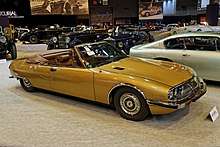
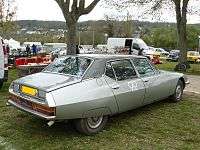
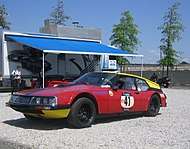
Coachbuilder Henri Chapron from Levallois-Perret produced several very collectible variants of the SM.
French Presidents from Georges Pompidou to Jacques Chirac have enjoyed touring Paris in the two 4-door convertible Citroën SM présidentielle models, sharing them with such notables as Queen Elizabeth II and Pope John Paul II. These manual transmission cars have special low gearing suitable for parade use.
Chapron also created five convertibles (SM Mylord) and seven sedans (SM Opéra). Original examples of these rare models are very valuable – the last MyLord sale recorded was for €548,320 in February 2014.[47] Some SM owners have made their own copies of the SM convertible in particular.[48] Unlike the DS, the factory never authorized a convertible model, as Citroën felt the roof was integral to the structure of the SM.[49] On the SM, the roof and rear quarter panels were welded on.
In 1971, Heuliez produced two examples of pillarless targa top convertible, the SM Espace.[50] Unlike the factory SM, the rear quarter windows could retract into the bodywork.
Just before the SM's demise, Citroën produced several short-wheelbase racing versions with squared-off rear sections and highly tuned engines – known as the "breadvan" model.
In the UK, three official RHD prototypes were constructed by Middleton Motors, a Citroën dealer in Hertfordshire, England. At least one of these prototypes still survives.
In Australia, 12 cars were converted to RHD by Chappel Engineering in Melbourne, Australia for Dutton's (the Australian importer of Citroën at the time).[51] Cars are still being modified with RHD controls and dashboards for the Australian market, where RHD is mandatory.
In the U.S., 100 cars were fitted with an electric sliding steel sunroof built by ASC.
Frua also proposed a concept car based on the SM, a front-wheel-drive car that closely resembled the mid-engine Maserati Merak.
In the spring of 1974, Maserati created a special 194 kW (260 hp) 4.0 L V8 engine based on the latest C114-11 engine variant. This engine, installed in a standard SM, tested over 12,000 kilometers. The engine was then removed and preserved, while the rest of the car was destroyed by Alejandro de Tomaso. The SM Club of France created an exact replica of this car using the actual engine from the original and displayed it at the Rétromobile 2010 show.[39]
Unfortunately, the intended recipient never received this V8. The Maserati Quattroporte II was a Maserati-badged, four-door variant of the SM with an angular body and lengthened floorpan. The six headlights were retained and the later 'SS' version of the engine fitted. This model was introduced at the time of Citroën's bankruptcy in 1974. It entered production in 1976 and only twelve were produced between then and 1978.[52]
Prominent owners
.jpg)
Like the Citroën DS, the SM has had many celebrity owners.[11] General Secretary of the Communist Party of the USSR Leonid Brezhnev,[53] Rolling Stones bassist Bill Wyman,[54] Adam Clayton of the rock group U2,[55] and Emperor Haile Selassie I of Ethiopia each drove SMs, while Ugandan dictator Idi Amin had seven of them.[56] The Shah of Iran drove an SM.
Actors Lorne Greene and Lee Majors, composer John Williams, author Graham Greene, and former Mauritian QC and Politician Sir Gaetan Duval (1930–1996), football player Johan Cruijff, Rolling Stones drummer Charlie Watts, Cheech & Chong's Cheech Marin and Thomas Chong,[57] motorcycle racer Mike Hailwood,[58] composer John Barry, & musician Carlos Santana, all owned SMs as well.[59] Popular Yugoslav and Croatian singer Mišo Kovač had his very own golden SM.
Currently, Guy Berryman of Coldplay drives an SM.[60] Television host and comedian Jay Leno's SM is seen frequently in the background of his Jay Leno's Garage YouTube videos.[61]
Media appearances
The SM has made prominent appearances in several films, TV series, video games, and music videos:
- Burt Reynolds escapes a fleet of police cars behind the wheel of a stolen SM in the 1974 film The Longest Yard. As he leaves the house, the female owner of the SM shouts "don't take my Maserati!".[62] At a quayside, Reynolds gets out of the car, nudges it into gear, and it drives into the water. In real life, Reynolds liked the car so much that he gave a 1973 SM Automatique[63] to his friend Dinah Shore.[64]
- Ben Stiller is kidnapped by Katinka (Milla Jovovich) in a green SM during the 2001 film Zoolander, so he can be brainwashed into becoming an unwitting assassin
- Yves Montand chases after love interest Romy Schneider in his SM in the 1972 French film César and Rosalie
- Charles Bronson foils a kidnapping attempt by Paul Mantee and his SM in the 1975 film Breakout
- In the 1980 Spanish film Navajeros, which tells the story of a famous mid 1970s juvenile delinquent nicknamed "El Jaro", the main actor (José Luis Manzano), steals an SM in order to impress a girl (Verónica Castro)
- Jerry Seinfeld drives an SM in the Dave Chappelle episode of the American web series Comedians in Cars Getting Coffee (Season 10, Episode 2)
- Patrick McGoohan drives an SM in a 1975 episode of the American television series Columbo ("Identity Crisis", Season 5, Episode 3)
- Gerry Anderson's 1971 television series The Protectors featured a platinum blue SM
- In German crime series Tatort, the SM is used in a kidnapping and a chase scene in Episode 47 "Die Rechnung wird nachgeliefert" (1975)
- Sven Väth and Miss Kittin drive a modified Citroën SM in their video from the single "Je t'aime... moi non plus"
- Norwegian composer Kaada features an SM in his 2001 music video "No You Don't"
- Janet Jackson appears in an SM with a red leather interior in the music video for the 1998 song "I Get Lonely" from the Velvet Rope album
- Dolores O'Riordan is almost run over by a silver SM driven by Mike Hogan, while Mike's brother, Noel Hogan, travels in the front passenger seat, in the music video for the 1999 song "Just My Imagination" from The Cranberries Bury the Hatchet album
- Trisha Yearwood's 1998 music video of "There Goes My Baby" prominently features an SM driven by her lover
- Emma Marrone drives an SM throughout her music video for the 2010 song "Cullami" from the A me piace così album
- The 2013 video game Grand Theft Auto V features a fictional car named the Lampadati Pigalle, part of the "I am not a hipster" update, which is loosely based on the SM
- An SM Opéra is used extensively in advertising for John-Paul Gaultier Scandal perfume, first aired in the UK 2017
References
Notes
- "1970 Citroen SM Coupe performance data, specs & photo". Automobile-catalog.com. Retrieved 28 November 2011.
- "DS – the Search for Speed". Citroenet. 1996.
- "Citroën SM – Hemmings Motor News". hemmings.com.
- "Reliving the golden era of French luxury". Automotive News. 29 October 2016. Retrieved 5 March 2017.
- webmaster. "Facel Vega Home Page". facel-vega.com.
- "A Maserati Collection II". Retrieved 18 February 2011.
- "1974 Citroën SM V8: A Mystery No More". Retrieved 18 February 2011.
- "Retrospective: Maserati Biturbo". carthrottle.com.
- Lars H. "1972 Espada V Jag E V Aston Martin V Citroen SM". espadatechsite.com.
- "Giant test Citroen SM 2.7 vs BMW 3.0 CS E9". CAR Magazine 1972
- Jonny Lieberman. "Citroen SM". Jalopnik.
- "Driving the Future – 1972 Citroën SM". Hemmings.
- "The Citroen SM". Motor Sport Magazine. December 1972. p. 44.
- "Citroen SM". How Stuff Works.
- Classic and Performance Car. "Classic Citroen cars for sale – Classic and Performance Car". classicandperformancecar.com.
- http://www.automobile-catalog.com/car/1972/127805/citroen_sm.html
- Quattroruote: Tutte le Auto del Mondo 74/75 (in Italian). Milano: Editoriale Domus S.p.A. 1974. p. 440.
- http://www.automobile-catalog.com/make/jensen/interceptor_2gen/interceptor_iii/1972.html
- http://www.automobile-catalog.com/make/bmw/2500-3_0cs_e09/2500-3_0cs_e09/1972.html
- http://www.automobile-catalog.com/make/jaguar/e-type_3/xke_3_fhc_22/1972.html
- http://www.automobile-catalog.com/make/lincoln/continental_mark_iv/continental_mark_iv_coupe/1972.html
- http://www.automobile-catalog.com/make/cadillac/eldorado_1971-1978/eldorado_1971-1978_hardtop/1972.html
- "Top 5: Citroen SM innovations that saw the future – CNET". CNET. CBS Interactive.
- Kozak, Graham (6 May 2015). "We drive the seductive Citroen SM, rad Renault 5 Turbo and other certifiable French classics". Autoweek. Hearst Autos, Inc.
- 'Wheel December 1970
- Buckley, Martin (February 2003). "Starstruck". Thoroughbred & Classic Cars. Emap Automotive, Peterborough, UK. p. 92.
- The Longest Yard – Lockdown Edition DVD, selection 02638, Paramount Home Entertainment, 2005
- LaChance, David (April 2007). "Reinventing the Wheel Leave it to Citroën to bring the world's first resin wheels to market". Hemmings. Retrieved 14 October 2015.
- http://www.cats-citroen.net/citroen_sm/sm_history.html
- Petrány, Máté (17 March 2014). "Michelin Made Carbon Fiber Wheels For Citroën Back In 1971". Jalopnik. Retrieved 31 July 2015.
- 'Motor Trend' magazine (USA), May 1970 issue
- "CITROËN SMCOLLECTIONNEZ-LA MAINTENANT !". Aon – LDA Classic Car. Archived from the original on 7 February 2015. Retrieved 6 February 2015.
- Clément-Collin, Paul (16 May 2015). "Citroën SM: la chute de «Sa Majesté»" [Citroën SM: "Her Majesty's" fall] (in French). Boitier Rouge. Archived from the original on 19 August 2015.
- Motor Trend February 1972
- Greiling Keane, Angela (28 March 2013). "Audi Wants to Change a 45-Year-Old U.S. Headlight Rule". BloombergBusinessweek. Retrieved 22 August 2016.
- Solomon, Jack (March 1978). "Billion Dollar Bumpers". Reason.
- Cropley, Steve (December 1979). "SM:Into the mystic". Car Magazine. p. 38.
- "Maserati Engines II". maserati-alfieri.co.uk.
- "1974 Citron SM V8: A Mystery No More – Autoweek". autoweek.com.
- "AutoTraderClassics.com – Article The lost prototype Reborn – Citroen SM V8". autotraderclassics.com.
- "Des Californiens fanatiques du Chevron". Le Figaro.
- "Citroën has a formidable back-catalogue of sometimes advanced but often unconventional vehicles. Its lengthy fight against mundane motoring convention produced love-it-or-hate-it folklore legends as diverse as the minimalist 2CV and streamlined DS. – West Briton". West Briton. Archived from the original on 2 April 2015. Retrieved 3 March 2015.
- Jan P. Norbye; Jim Dunne (December 1973). "European Thoroughbreds: What Are Their Secrets?". Popular Science. p. 40.
- Citroën SM' Osprey Autohistory, Jeff Daniels, 1981, ISBN 0-85045-381-X
- "1972 Citroen SM History, Pictures, Value, Auction Sales, Research and News". Conceptcarz.
- "The Cars of Citroën index". citroenet.org.uk.
- "Archived copy". Archived from the original on 23 September 2015. Retrieved 20 November 2014.CS1 maint: archived copy as title (link)
- "Citroën SM Chapron Cabriolet, oh Mylord !". Le Figaro.
- 'Citroën SM' Osprey Autohistory, Jeff Daniels, 1981, ISBN 0-85045-381-X
- "Archived copy". Archived from the original on 4 March 2016. Retrieved 31 January 2015.CS1 maint: archived copy as title (link)
- "Citroen SM Coupe (RHD) Auctions – Lot 24 – Shannons". shannons.com.au. Archived from the original on 29 November 2014. Retrieved 19 November 2014.
- Tabucchi, Maurizio (2003). Maserati: The Grand Prix, Sports and GT cars model by model, 1926–2003. Milano: Giorgio Nada Editore s.r.l. pp. 288–289. ISBN 8879112600.
- "Brezhnev and his Citroën SM". klassiekerlogeren.nl.
- "Two Bill Wyman cars to be auctioned at Goodwood Festival of Speed". The Telegraph. 6 May 2015. Archived from the original on 19 November 2015.
- "1972 Citroen SM 5-Speed". Bring a Trailer Auctions.
- "MinkMeister – Citroen SM". Some things matter.
- "Attaining Nirvana in a Citroën DS". Petrolicious. 20 February 2015. Archived from the original on 18 May 2015. Retrieved 14 May 2015.
- http://www.lap63.co.uk/#!sm-hailwood/cckw
- "AutoRAI 2003 – Johan Cruijf's SM". citroen1.info. Archived from the original on 14 August 2015. Retrieved 31 January 2015.
- TYLER HEATLEY (24 April 2019). "Check out Coldplay star Guy Berryman's garage". Motorious.
- "Jay Leno Ponders Charm (and Quirky Engineering) of French Cars". Popular Mechanics.
- "Jim Morekis – This is AWESOME. And yes I remember as a boy... – Facebook". facebook.com.
- "CCA Citroën SM Car Market". citroen-ca.com.
- "Career Couple". people.com.
Bibliography
- 'Citroën SM,' Osprey Autohistory, Jeff Daniels, 1981, ISBN 0-85045-381-X
- 'Motor Trend' magazine (USA), February 1972 issue
- 'Car and Driver' magazine (USA), June 1972 issue
- 'Popular Science' magazine (USA), December 1973 issue
- 'Motor Trend' magazine (USA), February 1974 issue
- 'Car Magazine' (UK), December 1979 issue
- 'Collectible Automobile' magazine (USA), June 2001 issue
- 'Thoroughbred & Classic Cars magazine (UK), April 1995 issue
- 'The Longest Yard – Lockdown Edition' DVD, selection 02638, Paramount Home Entertainment, 2005
External links
| Wikimedia Commons has media related to Citroën SM. |
- Ate Up With Motor: She Likes Whips and Chains: The Pleasures and Pains of the Citroën SM – a retrospective of the SM
- Curbside Classic: 1972 Citroen SM – Gran Touring, Franco-Italian Style – another retrospective of the SM
- Citroen SM Wiki
- Citroen SM at the Internet Movie Cars Database
.jpg)
.jpg)
